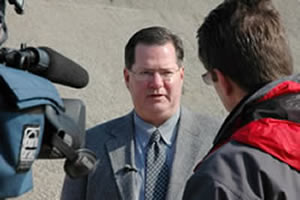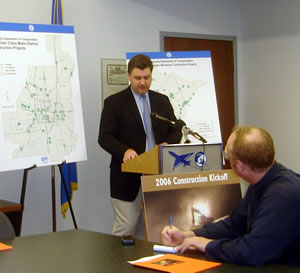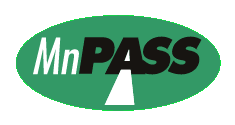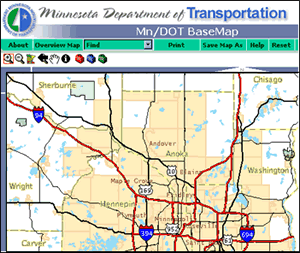 |
 |
|
 |
Mn/DOT announces 2006 highway construction program |
 |
 |
 |
|
Metro District's Tom O'Keefe, West Area manager, talks to a television reporter at a news conference March 29 near an Interstate 494 construction site in Minnetonka. Photo by David Gonzalez |
Mn/DOT officials today announced the state's 2006 summer road construction program. The program calls for investing $1.5 billion in more than 170 new or continuing highway improvement projects statewide. It includes 41 projects in the Twin Cities metro area and 131 in Greater Minnesota.
Lt. Gov./Commissioner Carol Molnau announced the program during a news conference near an Interstate 494 construction site in Minnetonka, as well as at stops in Moorhead, Rochester and Duluth. She was joined by district operations director Bob Winter, district officials and construction and maintenance staff.
At each location, Molnau stressed the importance of improving Minnesota’s highway system to increase safety and support the state’s economic vitality.
“Each project is an investment in traffic safety, congestion relief and support for the state’s economy,” Molnau said. “Every mile of highway we improve and every bridge we build supports our transportation system's ability to keep Minnesota an attractive place to live, work and do business.”
 |
Greg Paulson, District 6/Rochester assistant district engineer, presents the district's major construction projects for 2006 at a news conference in Rochester. Photo by Kristine Hernandez |
Winter presented an overview of projects across the state and thanked traffic reporters for helping Mn/DOT get the word out about the summer construction season.
"We look forward to an excellent construction season and want to remind motorists that we are in the work zone together," he said. "We need drivers to pay attention—prepare for the unexpected, be alert and use caution when they encounter work zones.”
In the Twin Cities, construction highlights include completing the expansion of I-494 between Hwy 5 and I-394, proceeding on the I-35E/I-694 "Unweave the Weave" project and breaking ground on the reconstruction of Hwy 62/I-35W.
In Greater Minnesota, highlights include building a freeway-style interchange on Hwy 52 in Oronoco, realigning three miles of Hwy 10 through Detroit Lakes and reconstructing the Trinity Road portion of Hwy 53 in Duluth.
The 2006 program is slightly smaller than last year’s which totaled 200 projects statewide and had a total investment of $1.7 billion.
“The 2006 program is a strong program, but it is smaller," said Molnau. "Future programs will be even further reduced until we have consistent additional funding sources for transportation. That's why the governor and I and many others support the proposal that all funds from the motor vehicle sales tax support transportation."
In related events, next week (April 3, 2006) is National Work Zone Safety Week. The week is designated at this time each year to remind drivers to be careful in and around road construction and maintenance work. For more information, visit Mn/DOT's Work Zone Safety Web site at www.dot.state.mn.us/workzone.
By Jeanne Aamodt
|
back

|
 |
Northstar corridor commuter rail project chugs ahead with FTA okay |
 |
 |
The Federal Transit Administration announced March 8 that it plans to give approval for the Northstar corridor commuter rail project to begin the final design stage of development.
“FTA approval allows the state to move ahead with final design activities, and have those activities eligible for partial reimbursement from the federal government,” said Bob McFarlin, assistant to the commissioner for transportation policy. "Moreover, FTA approval for final design is a clear and continuing signal that Northstar is a strong and financially sound commuter rail project that is worthy of federal support.”
The FTA announcement provides a boost to Gov. Tim Pawlenty’s proposal to the 2006 Legislature for $60 million in state bonding for the project. The $60 million proposal would be the last of the required state funds for the $289 million project; in 2005, the Legislature granted the project $37.5 million.
As proposed, the Northstar commuter rail will run between downtown Minneapolis and Big Lake , a distance of about 40 miles. Eventually, officials hope, the rail system will extend the entire length of the 82-mile transportation corridor to St. Cloud.
The project still has a number of issues to address before it can steam full ahead, including completing negotiations with the Burlington Northern Santa Fe railroad, on whose tracks the trains will run.
For more information, see:
|
back

|
 |
Towboat’s whistle blast makes it official: Mississippi River shipping season opens |
 |
 |
 |
|
The towboat Itasca carries Lt. Gov./ Commissioner Carol Molnau March 20 as she joined St. Paul Mayor Chris Coleman, officials from the U. S. Army Corps of Engineers and business leaders to open the Mississippi River shipping season. Photo by David Gonzalez |
Lt. Gov./Commissioner Carol Molnau and other officials took turns pulling the whistle cord on the towboat Itasca on March 20, sounding the official start of the Mississippi River shipping season.
Two days later, the towboat Reggie V. pushed its load of barges upriver and through the ice pack on Lake Pepin, becoming the first tow of the season to arrive in the St. Paul harbor.
“She never stopped, although she slowed down to less than one mile an hour in the heavy ice,” said Ed Williams, an official with Upper River Services of St. Paul.
“The Reggie V. arrived six days earlier than last year; we hope that’s a good omen for 2006,” said Dick Lambert, director of Mn/DOT’s Waterways Section.
The vessel, Lambert said, delivered 12 barges containing cement and fertilizer. He said several other tows have arrived upriver after the Reggie V. An aggregate company based on Grey Cloud Island in Cottage Grove has started shipping sand and gravel downriver as well, he said.
Lambert said shipping industry officials are hopeful that this year’s season will blunt a decline in river shipping during the past few years.
By Craig Wilkins
|
back

|
 |
MnPASS evaluation finds I-394 Express lanes working, earning public acceptance |
 |
 |
 |
|
The MnPASS I-394 Express Lanes project is meeting its goals and the majority of users support the project, according to evaluation results released March 23. |
Preliminary results from an ongoing evaluation of the MnPASS I-394 Express Lanes project released March 23 show that the project is meeting its goals and the majority of users support the project.
“What we are seeing and hearing here is very good news,” said Lt. Gov./Commissioner Carol Molnau. “This is an interim report and there is much more data to collect and analyze. But it does appear that the project is working and earning public acceptance.”
The comprehensive evaluation for the I-394 MnPASS Express Lanes project has two components:
- A public opinion survey of 549 users of the I-394 corridor conducted by the University of Minnesota Humphrey Institute of Public Affairs with NuStats, Inc., a Texas survey research firm
- A technical analysis of the operations of the system, conducted by Cambridge Systematics of Boston, Mass., and managed by Mn/DOT
The preliminary technical analysis indicates that the MnPASS system allows more vehicles to use the I-394 MnPASS lanes during peak periods where congestion is typically highest, without negatively affecting the travel of existing HOV lane users.
The study also has found that travel speeds in the non-MnPASS general purpose lanes have shown a slight increase during the peak travel periods when the MnPASS system is operational. This may be due in part to an easing of congestion when MnPASS users shift from the congested general purpose lanes to the MnPASS lanes.
Preliminary evaluation results also indicate that respondents approve of the MnPASS system by a two-to-one margin, with 59 percent saying it’s a “good idea” and 29 percent saying it’s a “bad idea.”
When the MnPASS lanes opened in May 2005, there were more than 3,300 subscribers to the service. Currently there are more than 9,400 subscribers.
For more information:
By Kevin Gutknecht
|
back

|
 |
Mn/DOT fleet resumes use of biodiesel fuels |
 |
 |
Mn/DOT’s snowplows and other diesel-powered vehicles now burn biodeisel, a diesel fuel that includes two percent of its volume derived from corn, soybeans or animal fats.
Fuels containing animal fats may include those made from grease used for cooking french fries and other foods.
Use of biodiesel was suspended earlier this year because a bad batch of the fuel clogged filters and caused other operational problems, said John Scharffbillig, fleet manager, Office of Maintenance.
The situation has been remedied by the fuel’s refiners.
“We’ve been using the two percent biodiesel since Feb. 10 without any problems,” he said.
The use of biodiesel follows an executive order by Gov. Tim Pawlenty that state agencies use biodiesel and E-85, a blend of 85 percent ethanol made from corn and 15 percent gasoline.
The governor’s order stresses the use of non-petroleum fuels in order to reduce the need for imported oil, cut pollution and provide an additional market for the state’s corn and soybean growers.
Scharffbillig said Mn/DOT used about 2.2 million gallons of diesel fuel last year for its vehicle fleet.
This fall, he said, Mn/DOT will start using an ultra-low sulfur content biodiesel fuel that reduces the level of sulfur dioxide released into the atmosphere.
Scharffbillig said the momentum for biodiesel and other biofuel continues to accelerate.
“In fact,” he said, “one legislator has introduced a bill (House File 2927) that would require that we use five percent of biodiesel from April through October.”
By Craig Wilkins
|
back

|
 |
Human Resources reorganization focuses on attracting, keeping good people |
 |
 |
The Office of Human Resources is making a number of changes to help address changing workforce needs and meet the challenges of the future.
“Increased retirements and loss of education options could mean a serious loss of expertise at Mn/DOT,” said Susan Mulvihill, interim Human Resources director. “We need to find better ways to attract and retain qualified employees as well as manage and retain our current employees.”
These changes involve reorganizing to create a section called Strategic Staffing, Workforce Planning, and Human Resource Information Systems headed by Wayne Brede.
“Including HR information systems in this section will help us see workforce trends that will help support decisions,” Mulvihill said.
Changes also involve making the Employee Development and Retention Section, previously part of the Office of Workforce Development, part of OHR.
“This section will focus on getting a better understanding of what employee development needs are out there and what development opportunities will enhance work experiences so employees feel valued,” Mulvihill said. “The section will look at the changing face of our agency in order to better understand the needs of different generations and cultures.”
The Staffing Services, Class & Compensation and Recruitment section, headed by Theresa Johnson, is merging with HR staff from the Business Services Section of the Office of Civil Rights and Administrative Services. The Benefits and SEMA4 staff will also move to 5th floor in Central Office during the next few weeks.
“This merger will help ensure coordinated and timely human resources services for Central Office and District Operations,” Mulvihill said. “It also will allow for more immediate access to office or district contacts.”
The Labor Relations section will continue under the direction of Rich Peterson.
“This is an area that will continue to look at the issue of managing employees,” Mulvihill said. “As the department changes and staff reductions occur, good sound employee management is a key to future success. Supervisors, managers, and employees benefit from being able to utilize the resources in Labor Relations.”
The Office of Affirmative Action, headed by Lynnette Geschwind, and the Risk Management Section, headed by Deb Ledvina, will collaborate and communicate with OHR as needed, especially in the areas of recruitment, safety, worker’s compensation and labor relations.
OHR conducted preliminary research with managers and employees to determine what’smost important and how to better meet customer needs. After the reorganization, random surveys will be sent to customers to measure the performance of the new structure and help guide improvements.
“The first goal of the OHR reorganization is to provide a one-stop shop for planning, staffing and employee development needs,” Mulvihill said. “The second goal is to provide superior customer service. The ultimate goal is Mn/DOT being able to recruit and retain the best workforce possible.”
The OHR Web site http://ihub.hrapps.dot.state.mn.us/index.asp will be revised over the next few weeks to reflect the reorganization and changes in services. Mulvihill advises employees to check the Web site for developments.
For more information about OHR changes, contact Mulvihill at 651/296-7207.
By Donna Lindberg
|
back

|
 |
Thompson accepts post as Metro District’s East Area manager |
 |
 |
 |
|
Nick Thompson Photo by Teresa Callies |
Nick Thompson, currently freeway operations manager at the Regional Transportation Management Center in Roseville, has accepted the position of East Area manager with the Metro District, said Khani Sahebjam, Metro District engineer.
His appointment becomes effective April 19.
Thompson will be one of four Metro District area managers and will lead the delivery of transportation projects within the east Twin Cities metro area (Chisago and Washington Counties).
His past Mn/DOT experience includes managing the ramp meter program, RTMC Control Room operations, traveler information programs, freeway incident responders and incident management initiatives. He has also served as the project manager of the I-394 MnPASS Express Lane.
Thompson, who started at Mn/DOT in 1996, holds a master’s degree in urban planning from the University of Wisconsin-Milwaukee, and a bachelor of arts degree from Gustavus Adolphus College.
Thompson’s new office is located at the Waters Edge building in Roseville; his phone number will be 651/582-1406.
|
back

|
 |
New on the Web: interactive basemap for viewing spatial data |
 |
 |
 |
|
This is how the new interactive basemap will look in Web browsers. Depending on their needs, users will have the ability to zoom-in, zoom-out and turn additional layers of data on or off. |
Planners, designers, project managers and others now have another digital tool to help them do their jobs: Mn/DOT’s new interactive basemap Web service.
The operative word is “interactive.”
Mn/DOT’s basemap, which has been around since 1995, is a set of transportation-related data developed specifically for use in a geographic information system. The basemap includes both transportation data (public roads, railroads, airports and navigable waters) and boundary information (state, county, city, township, state and federal parks, forests, Indian reservations, streams and lakes). The data is displayed at a scale of 1:24,000.
Previously the basemap data was static, updated yearly and accessible only by CD-ROM. Now, the basemap data is continuously updated, and the new Web site allows users to view the data in a browser or load the data service in their own software, e.g., ArcGIS or ArcExplorer (a free viewing software). Users also may view, save and print maps.
“Providing the data through an easy-to-use Web browser and having the ability to use the service outside of the browser makes it easier and faster for Mn/DOT employees and external customers to access the data and helps Mn/DOT work better,” said Dan Ross, supervisor, Office of Information Technology.
“The interactive basemap serves as a core template and is reusable for offices to build upon for their own business area needs,” Ross said. “In the future, we will see customized versions of this site display data for right of way, rail grade crossings, bikeways and Metro District construction.”
How it works
The interactive basemap opens with a statewide view showing county boundaries and highways. Basic tools are provided to zoom in and out, to pan and to identify information. When users zoom into a district or county, more roadway features automatically appear.
Users also turn on additional spatial data layers. For example, users can turn on the color aerial imagery to provide background information or you could view the annual average daily traffic values on a highway.
Advanced tools are provided for users to query, select, markup and measure using the graphic user interface. For example, users can locate specific wetlands that are within a specified distance (buffer) of any roadway. Users also can add lines, polygons and text to markup an analysis area. The map can then be printed and shared with customers.
Development of this Web service was collaborative, with project initiation and support from the Office of Land Management, application development from the Office of Information Technology, and statewide core basemap layers from the Office of Transportation Data and Analysis.
If you have any questions or comments, contact gis.info@dot.state.mn.us.
For more information
By Crystal Phillips- Mustain, Office of Transportation Data and Analysis
|
back

|
 |
|
 |



